c语言 时间计算器函数
- 格式:doc
- 大小:15.79 KB
- 文档页数:11
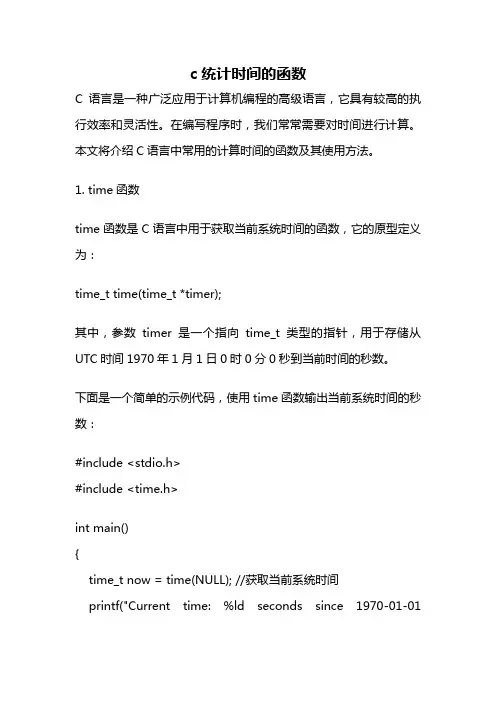
c统计时间的函数C语言是一种广泛应用于计算机编程的高级语言,它具有较高的执行效率和灵活性。
在编写程序时,我们常常需要对时间进行计算。
本文将介绍C语言中常用的计算时间的函数及其使用方法。
1. time函数time函数是C语言中用于获取当前系统时间的函数,它的原型定义为:time_t time(time_t *timer);其中,参数timer是一个指向time_t类型的指针,用于存储从UTC时间1970年1月1日0时0分0秒到当前时间的秒数。
下面是一个简单的示例代码,使用time函数输出当前系统时间的秒数:#include <stdio.h>#include <time.h>int main(){time_t now = time(NULL); //获取当前系统时间printf("Current time: %ld seconds since 1970-01-0100:00:00 UTC\n", now);return 0;}2. clock函数clock函数是C语言中用于计算程序运行时间的函数,它的原型定义为:clock_t clock(void);其中,返回值为clock_t类型,表示程序运行的CPU时间。
下面是一个示例代码,使用clock函数计算程序运行时间:#include <stdio.h>#include <time.h>int main(){clock_t start, end;double cpu_time_used;start = clock(); //记录程序开始时间//程序运行end = clock(); //记录程序结束时间cpu_time_used = ((double) (end - start)) / CLOCKS_PER_SEC; //计算CPU时间printf("CPU time used: %f seconds\n", cpu_time_used);return 0;}3. difftime函数difftime函数是C语言中用于计算两个时间之间的时间差的函数,它的原型定义为:double difftime(time_t time1, time_t time2);其中,参数time1和time2分别为两个时间,返回值为double类型,表示两个时间之间的差值(以秒为单位)。
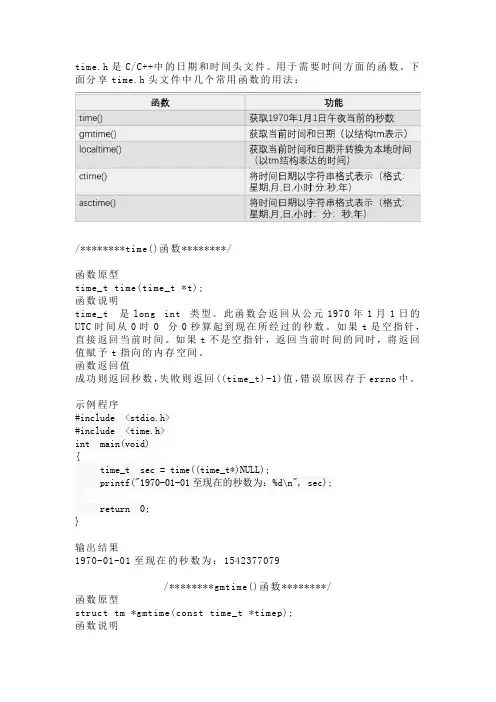
time.h是C/C++中的日期和时间头文件。
用于需要时间方面的函数。
下面分享time.h头文件中几个常用函数的用法:/********time()函数********/函数原型time_t time(time_t *t);函数说明time_t 是long int 类型。
此函数会返回从公元1970年1月1日的UTC时间从0时0 分0秒算起到现在所经过的秒数。
如果t是空指针,直接返回当前时间。
如果t不是空指针,返回当前时间的同时,将返回值赋予t指向的内存空间。
函数返回值成功则返回秒数,失败则返回((time_t)-1)值,错误原因存于errno中。
示例程序#include <stdio.h>#include <time.h>int main(void){time_t sec = time((time_t*)NULL);printf("1970-01-01至现在的秒数为:%d\n", sec);return 0;}输出结果1970-01-01至现在的秒数为:1542377079/********gmtime()函数********/函数原型struct tm *gmtime(const time_t *timep);函数说明gmtime()将参数timep所指的time_t结构中的信息转换成真实世界所使用的时间日期表示方法,然后将结果由结构tm返回。
结构tm的定义为:struct tm{int tm_sec; //代表目前秒数, 正常范围为0-59, 但允许至61 秒int tm_min; //代表目前分数, 范围0-59int tm_hour; //从午夜算起的时数, 范围为0-23int tm_mday; //目前月份的日数, 范围01-31int tm_mon; //代表目前月份, 从一月算起, 范围从0-11int tm_year; //从1900 年算起至今的年数int tm_wday; //一星期的日数, 从星期一算起, 范围为0-6int tm_yday; //从今年1 月1 日算起至今的天数, 范围为0-365int tm_isdst; //日光节约时间的旗标};函数返回值返回结构tm代表目前UTC时间。
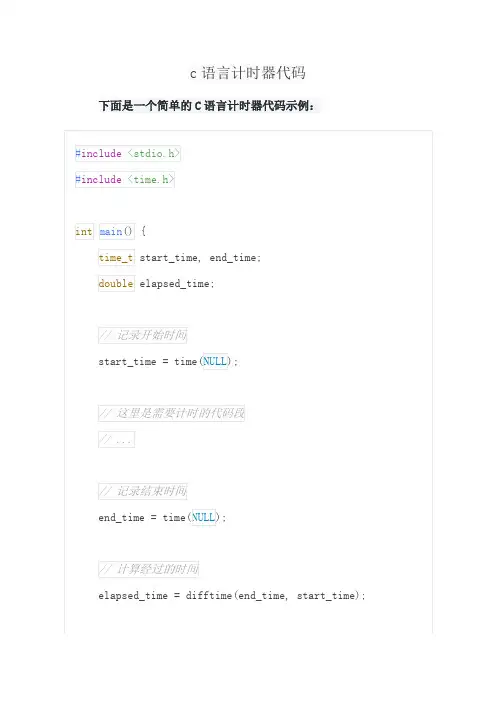
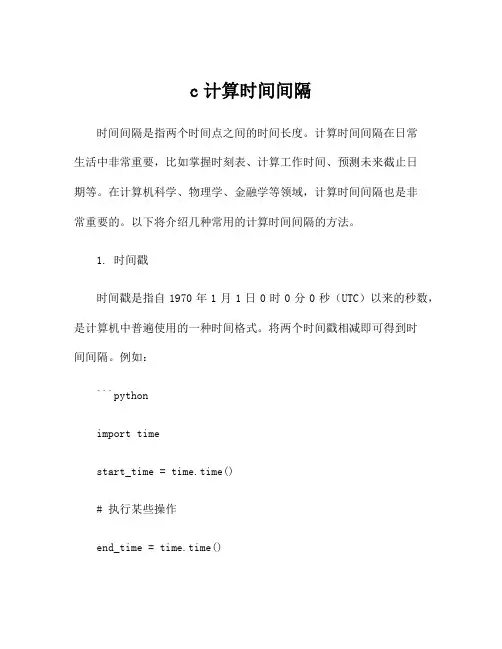
c计算时间间隔时间间隔是指两个时间点之间的时间长度。
计算时间间隔在日常生活中非常重要,比如掌握时刻表、计算工作时间、预测未来截止日期等。
在计算机科学、物理学、金融学等领域,计算时间间隔也是非常重要的。
以下将介绍几种常用的计算时间间隔的方法。
1. 时间戳时间戳是指自1970年1月1日0时0分0秒(UTC)以来的秒数,是计算机中普遍使用的一种时间格式。
将两个时间戳相减即可得到时间间隔。
例如:```pythonimport timestart_time = time.time()# 执行某些操作end_time = time.time()time_interval = end_time - start_timeprint("时间间隔为:", time_interval, "秒")```2. datetime模块Python datetime模块提供了一种更方便的计算时间间隔的方法。
使用datetime模块,可以轻松处理日期和时间。
下面的例子演示了如何使用datetime模块计算时间间隔:```pythonfrom datetime import datetimestart_time = datetime.now()# 执行某些操作end_time = datetime.now()time_diff = end_time - start_timetime_interval = time_diff.total_seconds()print("时间间隔为:", time_interval, "秒")```该方法将两个时间点转换为datetime对象,并使用total_seconds()函数计算时间差,从而得到时间间隔。
3. time模块Python time模块提供了许多与时间相关的函数,例如asctime、localtime、gmtime和strftime等。
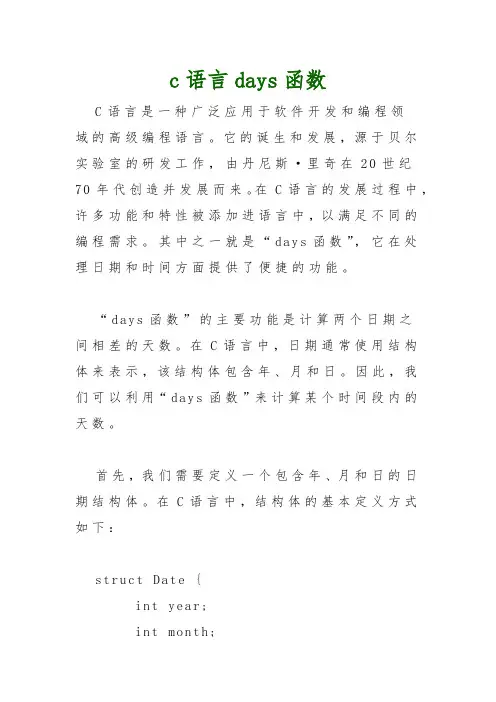
c语言days函数C语言是一种广泛应用于软件开发和编程领域的高级编程语言。
它的诞生和发展,源于贝尔实验室的研发工作,由丹尼斯·里奇在20世纪70年代创造并发展而来。
在C语言的发展过程中,许多功能和特性被添加进语言中,以满足不同的编程需求。
其中之一就是“d a y s函数”,它在处理日期和时间方面提供了便捷的功能。
“d a y s函数”的主要功能是计算两个日期之间相差的天数。
在C语言中,日期通常使用结构体来表示,该结构体包含年、月和日。
因此,我们可以利用“d a y s函数”来计算某个时间段内的天数。
首先,我们需要定义一个包含年、月和日的日期结构体。
在C语言中,结构体的基本定义方式如下:s t r u c t D a t e{i n t y e a r;i n t m o n t h;i n t d a y;};接下来,可以编写“d a y s函数”的原型,用于计算两个日期之间的天数。
i n t d a y s(s t r u c t D a t e s t a r t,s t r u c t D a t e e n d);在函数体内,我们可以通过以下步骤计算两个日期之间的天数:1.首先,需要计算起始日期和结束日期之间的年份差值,并将其存储在一个名为“y e a r s”的变量中。
可以通过`e n d.y e a r-s t a r t.y e a r`来实现这一点。
2.接下来,需要计算起始日期和结束日期在同一年内的月份差值,并将其存储在一个名为“m o n t h s”的变量中。
首先,我们需要计算结束日期的月份(`e n d.m o n t h`)加上12倍的结束年份(`e n d.y e a r * 12`),然后减去起始日期的月份(`s t a r t.m o n t h`)加上12倍的起始年份(`s t a r t.y e a r*12`)即可。
3.现在,我们已经计算出起始日期和结束日期之间所跨越的月份差值。
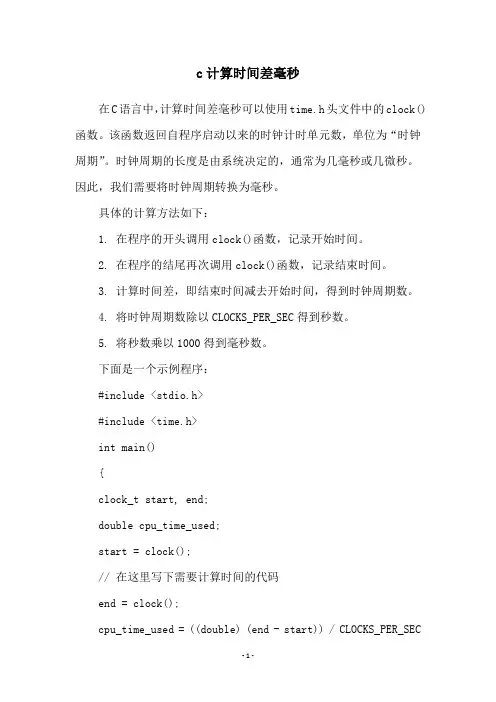
c计算时间差毫秒在C语言中,计算时间差毫秒可以使用time.h头文件中的clock()函数。
该函数返回自程序启动以来的时钟计时单元数,单位为“时钟周期”。
时钟周期的长度是由系统决定的,通常为几毫秒或几微秒。
因此,我们需要将时钟周期转换为毫秒。
具体的计算方法如下:1. 在程序的开头调用clock()函数,记录开始时间。
2. 在程序的结尾再次调用clock()函数,记录结束时间。
3. 计算时间差,即结束时间减去开始时间,得到时钟周期数。
4. 将时钟周期数除以CLOCKS_PER_SEC得到秒数。
5. 将秒数乘以1000得到毫秒数。
下面是一个示例程序:#include <stdio.h>#include <time.h>int main(){clock_t start, end;double cpu_time_used;start = clock();// 在这里写下需要计算时间的代码end = clock();cpu_time_used = ((double) (end - start)) / CLOCKS_PER_SEC* 1000;printf('程序运行时间为 %f 毫秒', cpu_time_used);return 0;}在上面的程序中,我们首先定义了两个clock_t类型的变量start和end,分别用于记录开始和结束时间。
然后在程序的开头调用clock()函数,记录开始时间。
接着写下需要计算时间的代码,最后在程序的结尾再次调用clock()函数,记录结束时间。
计算时间差并将其转换为毫秒数的代码如下:cpu_time_used = ((double) (end - start)) / CLOCKS_PER_SEC * 1000;最后,我们使用printf()函数输出程序的运行时间,格式化输出的代码如下:printf('程序运行时间为 %f 毫秒', cpu_time_used);运行以上程序,即可得到程序的运行时间。
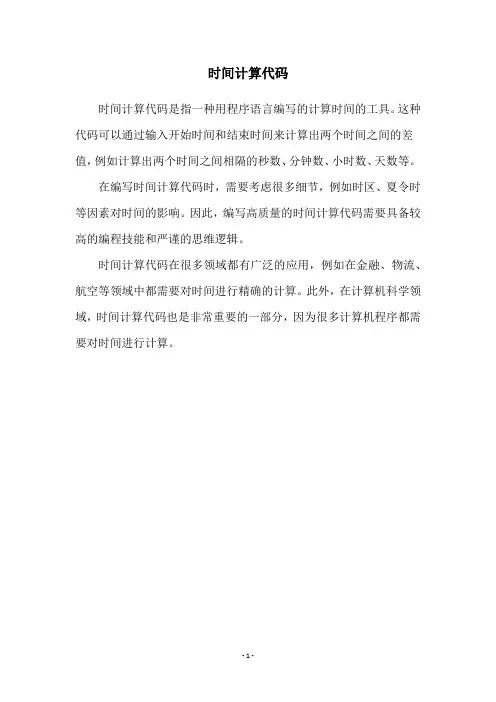
时间计算代码
时间计算代码是指一种用程序语言编写的计算时间的工具。
这种代码可以通过输入开始时间和结束时间来计算出两个时间之间的差值,例如计算出两个时间之间相隔的秒数、分钟数、小时数、天数等。
在编写时间计算代码时,需要考虑很多细节,例如时区、夏令时等因素对时间的影响。
因此,编写高质量的时间计算代码需要具备较高的编程技能和严谨的思维逻辑。
时间计算代码在很多领域都有广泛的应用,例如在金融、物流、航空等领域中都需要对时间进行精确的计算。
此外,在计算机科学领域,时间计算代码也是非常重要的一部分,因为很多计算机程序都需要对时间进行计算。
- 1 -。
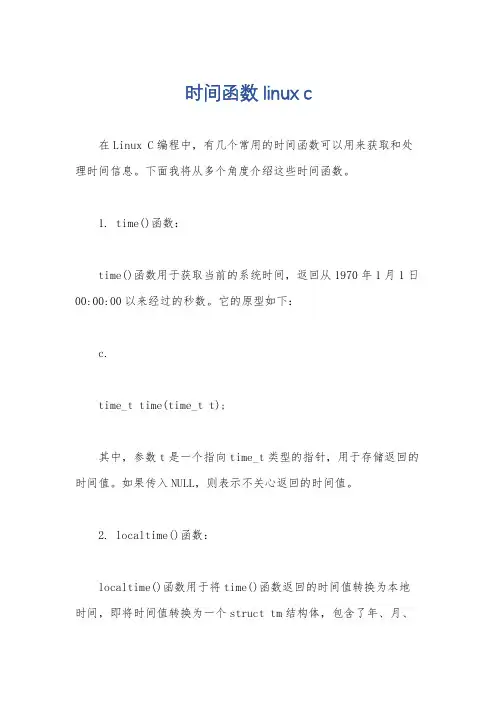
时间函数 linux c在Linux C编程中,有几个常用的时间函数可以用来获取和处理时间信息。
下面我将从多个角度介绍这些时间函数。
1. time()函数:time()函数用于获取当前的系统时间,返回从1970年1月1日00:00:00以来经过的秒数。
它的原型如下:c.time_t time(time_t t);其中,参数t是一个指向time_t类型的指针,用于存储返回的时间值。
如果传入NULL,则表示不关心返回的时间值。
2. localtime()函数:localtime()函数用于将time()函数返回的时间值转换为本地时间,即将时间值转换为一个struct tm结构体,包含了年、月、日、时、分、秒等信息。
它的原型如下:c.struct tm localtime(const time_t timep);其中,参数timep是一个指向time_t类型的指针,指向要转换的时间值。
函数返回一个指向struct tm结构体的指针。
3. strftime()函数:strftime()函数用于将struct tm结构体中的时间信息格式化为指定的字符串格式。
它的原型如下:c.size_t strftime(char str, size_t maxsize, const char format, const struct tm timeptr);其中,参数str是一个指向字符数组的指针,用于存储格式化后的时间字符串;maxsize是str数组的大小;format是一个格式控制字符串,用于指定输出的时间格式;timeptr是一个指向struct tm结构体的指针,指向要格式化的时间信息。
4. gettimeofday()函数:gettimeofday()函数用于获取当前的系统时间,返回从1970年1月1日00:00:00以来经过的秒数和微秒数。
它的原型如下:c.int gettimeofday(struct timeval tv, struct timezone tz);其中,参数tv是一个指向struct timeval结构体的指针,用于存储返回的时间值;参数tz是一个指向struct timezone结构体的指针,用于存储时区信息。
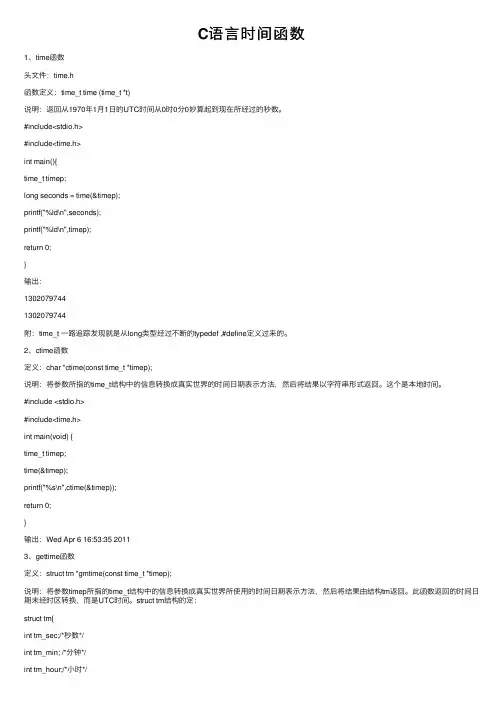
C语⾔时间函数1、time函数头⽂件:time.h函数定义:time_t time (time_t *t)说明:返回从1970年1⽉1⽇的UTC时间从0时0分0妙算起到现在所经过的秒数。
#include<stdio.h>#include<time.h>int main(){time_t timep;long seconds = time(&timep);printf("%ld\n",seconds);printf("%ld\n",timep);return 0;}输出:13020797441302079744附:time_t ⼀路追踪发现就是从long类型经过不断的typedef ,#define定义过来的。
2、ctime函数定义:char *ctime(const time_t *timep);说明:将参数所指的time_t结构中的信息转换成真实世界的时间⽇期表⽰⽅法,然后将结果以字符串形式返回。
这个是本地时间。
#include <stdio.h>#include<time.h>int main(void) {time_t timep;time(&timep);printf("%s\n",ctime(&timep));return 0;}输出:Wed Apr 6 16:53:35 20113、gettime函数定义:struct tm *gmtime(const time_t *timep);说明:将参数timep所指的time_t结构中的信息转换成真实世界所使⽤的时间⽇期表⽰⽅法,然后将结果由结构tm返回。
此函数返回的时间⽇期未经时区转换,⽽是UTC时间。
struct tm结构的定:struct tm{int tm_sec;/*秒数*/int tm_min; /*分钟*/int tm_hour;/*⼩时*/int tm_mday;/*⽇期*/int tm_mon; /*⽉份*/int tm_year; /*从1990年算起⾄今的年数*/int tm_wday; /*星期*/int tm_yday; /*从今年1⽉1⽇算起⾄今的天数*/int tm_isdst; /*⽇光节约时间的旗标*/};#include <stdio.h>#include<time.h>int main(void) {char *wday[] = {"Sun","Mon","Tue","Wed","Thu","Fri","Sat"};time_t timep;struct tm *p;time(&timep);p = gmtime(&timep);printf("%d/%d/%d ",(1900+p->tm_year),(1+p->tm_mon),p->tm_mday);printf("%s %d:%d:%d\n",wday[p->tm_wday],p->tm_hour,p->tm_min,p->tm_sec);return 0;}输出:2011/4/6 Wed 8:59:04、 asctime函数定义:char *asctime(const struct tm *timeptr);说明:将参数timeptr所指的struct tm结构中的信息转换成真实时间所使⽤的时间⽇期表⽰⽅法,结果以字符串形态返回。
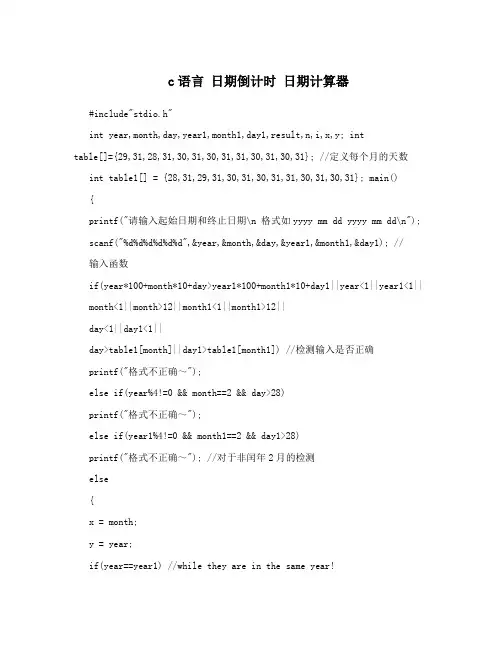
c语言日期倒计时日期计算器#include"stdio.h"int year,month,day,year1,month1,day1,result,n,i,x,y; inttable[]={29,31,28,31,30,31,30,31,31,30,31,30,31}; //定义每个月的天数int table1[] = {28,31,29,31,30,31,30,31,31,30,31,30,31}; main(){printf("请输入起始日期和终止日期\n 格式如yyyy mm dd yyyy mm dd\n");scanf("%d%d%d%d%d%d",&year,&month,&day,&year1,&month1,&day1); //输入函数if(year*100+month*10+day>year1*100+month1*10+day1||year<1||year1<1|| month<1||month>12||month1<1||month1>12||day<1||day1<1||day>table1[month]||day1>table1[month1]) //检测输入是否正确printf("格式不正确~");else if(year%4!=0 && month==2 && day>28)printf("格式不正确~");else if(year1%4!=0 && month1==2 && day1>28)printf("格式不正确~"); //对于非闰年2月的检测else{x = month;y = year;if(year==year1) //while they are in the same year!{if(month==month1) // and the same month!result = day1-day; // so....else //the same year but different monthes.{if(year%4==0 && month==2)result = table[0]-day;elseresult = table[month]-day; //英语不够用啦,先将起始年的起始月剩余天数算出。
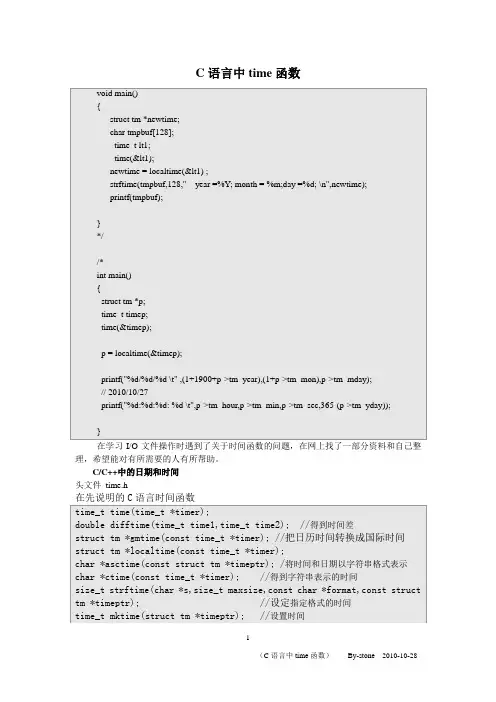
C语言中time函数在学习I/O文件操作时遇到了关于时间函数的问题,在网上找了一部分资料和自己整理,希望能对有所需要的人有所帮助。
C/C++中的日期和时间头文件time.hasctime(将时间和日期以字符串格式表示)定义函数char * asctime(const struct tm * timeptr);函数说明asctime()将参数timeptr所指的tm结构中的信息转换成真实世界所使用的时间日期表示方法,然后将结果以字符串形态返回。
此函数已经由时区转换成当地时间,字符串格式为:"Wed Jun 30 21:49:08 1993\n"返回值若再调用相关的时间日期函数,此字符串可能会被破坏。
此函数与ctime不同处在于传入的参数是不同的结构。
附加说明返回一字符串表示目前当地的时间日期。
ctime(将时间和日期以字符串格式表示)定义函数char *ctime(const time_t *timep);函数说明ctime ()将参数timep所指的time_t结构中的信息转换成真实世界所使用的时间日期表示方法,然后将结果以字符串形态返回。
此函数已经由时区转换成当地时间,字符串格式为"Wed Jun 30 21 :49 :08 1993\n"。
若再调用相关的时间日期函数,此字符串可能会被破坏。
返回值返回一字符串表示目前当地的时间日期。
范例#i ncludemain(){time_t timep;time (&timep);printf("%s",ctime(&timep));}执行Sat Oct 28 10 : 12 : 05 2000gettimeofday(取得目前的时间)定义函数int gettimeofday ( struct timeval * tv , struct timezone * tz )函数说明gettimeofday()会把目前的时间有tv所指的结构返回,当地时区的信息则放到tz所指的结构中。
关于vc c 时间函数的总结关于vcc时间函数的总结关于vc/c++时间函数的总结首先看看几个函数的原型的声明(在time.h中):clock_tclock(void)clock_t是用来保存时间的数据类型,是long型doubledifftime(time_ttime1,time_ttime0);挑时间间隔的函数time_ttime(time_t*timer);日历时间函数char*asctime(conststructtm*timeptr);将tm类的时间结构转变为紧固时间格式char*ctime(consttime_t*timer);将日历时间转化为固定时间格式time_tmktime(structtm*timeptr);以年、月、日、时、分后、秒等分量留存的时间结构structtm*gmtime(consttime_t*timer);将日历时间转化为格林尼治时间structtm*localtime(consttime_t*timer);将日历时间转变为当地时间structtimeval结构体在time.h中的定义为:structtimevaltime_ttv_sec; /*seconds.*/suseconds_ttv_usec; /*microseconds.*/其中,tv_sec为epoch到创建structtimeval时的秒数,tv_usec为微秒structtimeval结构体在time.h中的定义为:structtimevaltime_ttv_sec; /*seconds.*/suseconds_ttv_usec; /*microseconds.*/其中,tv_sec为epoch至建立structtimeval时的秒数,tv_usec为微秒数,即为秒后面的零头。
比如说当前我写下博文时的tv_sec为1244770435,tv_usec为442388,即为当前时间距epoch时间1244770435秒,442388微秒。
c语言时间计算器函数
英文回答:
A time calculator function in C language can be used to perform various calculations related to time, such as converting between different time formats, adding or subtracting time intervals, and calculating the duration between two points in time. Here's an example of a simple time calculator function in C:
c.
#include <stdio.h>。
#include <stdlib.h>。
typedef struct {。
int hours;
int minutes;
int seconds;
} Time;
Time time_add(Time t1, Time t2) {。
Time result;
result.hours = t1.hours + t2.hours;
result.minutes = t1.minutes + t2.minutes;
result.seconds = t1.seconds + t2.seconds;
// Handle the case when the seconds exceed 60。
if (result.seconds >= 60) {。
result.seconds -= 60;
result.minutes++;
}。
// Handle the case when the minutes exceed 60。
if (result.minutes >= 60) {。
result.minutes -= 60;
result.hours++;
}。
return result;
}。
Time time_subtract(Time t1, Time t2) {。
Time result;
result.hours = t1.hours t2.hours;
result.minutes = t1.minutes t2.minutes;
result.seconds = t1.seconds t2.seconds;
// Handle the case when the seconds become negative. if (result.seconds < 0) {。
result.seconds += 60;
result.minutes--;
}。
// Handle the case when the minutes become negative. if (result.minutes < 0) {。
result.minutes += 60;
result.hours--;
}。
return result;
}。
int main() {。
Time t1 = {1, 30, 45};
Time t2 = {0, 45, 30};
Time result = time_add(t1, t2);
printf("Time after addition: %d:%d:%d\n", result.hours, result.minutes, result.seconds);
result = time_subtract(t1, t2);
printf("Time after subtraction: %d:%d:%d\n",
result.hours, result.minutes, result.seconds);
return 0;
}。
In this example, we define a Time struct to represent time in hours, minutes, and seconds. The time_add and
time_subtract functions take two Time structs as input and return a new Time struct with the calculated result. The main function demonstrates how to use these functions by adding and subtracting two Time structs and printing the results.
中文回答:
一个C语言的时间计算器函数可以执行各种与时间相关的计算,比如不同时间格式之间的转换、时间间隔的加减以及计算两个时间
点之间的持续时间。
下面是一个C语言中简单的時間计算器函数示例:
c.
#include <stdio.h>。
#include <stdlib.h>。
typedef struct {。
int 小时;
int 分钟;
int 秒钟;
} 时间;
时间时间_相加(时间 t1, 时间 t2) {。
时间结果;
结果.小时 = t1.小时 + t2.小时;
结果.分钟 = t1.分钟 + t2.分钟;
结果.秒钟 = t1.秒钟 + t2.秒钟; // 处理秒钟超过60的情况。
if (结果.秒钟 >= 60) {。
结果.秒钟 -= 60;
结果.分钟++;
}。
// 处理分钟超过60的情况。
if (结果.分钟 >= 60) {。
结果.分钟 -= 60;
结果.小时++;
}。
return 结果;
}。
时间时间_相减(时间 t1, 时间 t2) {。
时间结果;
结果.小时 = t1.小时 t2.小时;
结果.分钟 = t1.分钟 t2.分钟;
结果.秒钟 = t1.秒钟 t2.秒钟;
// 处理秒钟变成负数的情况。
if (结果.秒钟 < 0) {。
结果.秒钟 += 60;
结果.分钟--;
}。
// 处理分钟变成负数的情况。
if (结果.分钟 < 0) {。
结果.分钟 += 60;
结果.小时--;
}。
return 结果;
}。
int 主函数() {。
时间 t1 = {1, 30, 45};
时间 t2 = {0, 45, 30};
时间结果 = 时间_相加(t1, t2);
printf("加法后的时间: %d:%d:%d\n", 结果.小时, 结果.
分钟, 结果.秒钟);
结果 = 时间_相减(t1, t2);
printf("减法后的时间: %d:%d:%d\n", 结果.小时, 结果.
分钟, 结果.秒钟);
return 0;
}。
在这个例子中,我们定义了一个时间结构体来表示时间的小时、分钟和秒钟。
time_add 和 time_subtract 函数分别接受两个时间
结构体作为输入,并返回一个计算结果的新时间结构体。
主函数演
示了如何使用这些函数通过添加和减去两个时间结构体并打印结果
来使用这些函数。